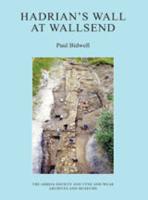
Arbeia Society and Tyne and Wear Archives and Museums (2018) 262pp £35 (ISBN 9781527229969)
The fort at Wallsend (Segedunum) marks the eastern end of Hadrian’s Wall. This book provides a comprehensive report of the excavations at Buddle Street, which lies to the west of the fort. The excavations have been carried out in stages since 1991, when the site was acquired by North Tyneside Council. The book also sets the findings at Buddle Street into their broader context.
The author has divided the relevant history into five periods. Period 1 runs from the original construction to the end of the second century. The wall between Newcastle and Wallsend was narrow gauge. This terminal section and the adjoining fort were built at the same time as the main run of the wall. The line of the wall ran diagonally across a small valley at the west end of the Buddle Street site. To prevent subsidence, the foundations here were unusually deep. They comprised sandstone rubble or slabs and cobbles, packed around with clay. An aqueduct from the south delivered water to the fort, the fort baths and other extramural buildings. Chapter 4 describes the original water distribution system, which involved three channels passing through the base of wall. In the 160s a large cistern was installed at the fort, south of the via principalis and near to the east gate. The cistern had a capacity to hold some 33,000 litres of water.
At around the end of the second century, the unit stationed at Segedunum and at many locations in the north east were much reduced in size. The author speculates (p. 73) that after the defeat of the British legions at Lyon in AD 197, units in Brigantia may have been kept under strength until their loyalty was assured. Severus achieved such reassurance during the Scottish campaigns at the end of his reign.
Two sections of wall collapsed at the beginning of the third century, probably due to flooding and lack of maintenance. A rebuilding operation during the Severan period marks the beginning of period 2 (early third century). The aqueduct was rebuilt on a different line, passing through the wall by means of a culvert. At the same time defences were provided to the vicus outside the fort. During period 2 the soldiers at Segedunum installed obstacles in the berm to the north of the wall. All that remains now of those obstacles are post holes. These are in a quincunx pattern. The remains of similar obstacles have been found in the berm to the east and west of Newcastle.
A further collapse of the wall occurred in period 3 (mid-third century). It was in the same area as the previous collapse and probably due to the same causes. During this period the area to the north of the wall was divided into small fields by a series of gullies. A stone building appeared in that area, presumably linked to agriculture. Another series of gullies was cut across the berm at the east end of the site. These emptied into the ditch beyond the berm and must have been designed to carry water away from the wall. By then flood water had caused more than enough damage and bother.
Period 4 spans the last quarter of the third century. The wall collapsed at the west end of the site and more rebuilding works followed. This time the builders used stone blocks and architectural fragments from the fort gates. The aqueduct was reinstated, slightly to the east of its previous position. Ten iron arrowheads were buried during this period. They lay in an arc and were almost certainly a ritual deposition.
Period 5 spans the fourth century and the early fifth century. There were further wall collapses and repairs, but by now the long period of decay was beginning. Silt accumulated against both faces of the wall. This contained pottery fragments, all post-dating AD 360. In later centuries the site had many different occupants and uses. During the eighteenth and nineteenth centuries it formed part of a colliery. By the twentieth century, the Roman level was buried some 3 metres below ground surface.
This is a delightful book to read, clearly illustrated with photographs and diagrams. It is also packed with interesting detail. Chapters contributed by others deal with pottery finds, stonework, coins recovered (including two Antonine denarii) and analysis of the mortars used. The book occupied this reviewer most enjoyably throughout a flight to Singapore, but it is not a book for everyone. It pre-supposes a knowledge of Roman history in general and Roman Britain in particular. To all readers with an interest in the subject, I warmly commend it.
Rupert Jackson
